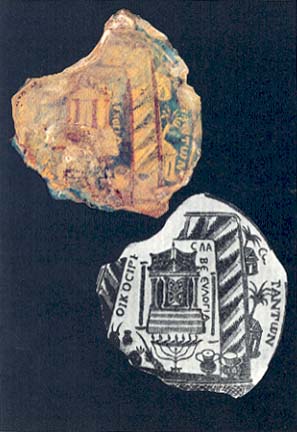Image Details

Vatican Library
Gold glass is well known from Rome and Alexandria. Craftsmen placed gold foil on a piece of glass, removed some of the gold and then covered the foil with a second piece of glass. This fragment, discovered in a catacomb in Rome, dates from the third or fourth century A.D. However, the design it bears may preserve a memory of the trapezium shape of the Temple compound when it stood in Jerusalem two or three centuries earlier.
Details not visible in the photograph are shown in the drawing. These details can be seen if the glass is held and turned in different ways toward a light. The incomplete phrase to the left of the Hékhal may have read “House of Peace.” Below the Hékhal (and also on its lintel) is a seven branched lampstand (a menorah). To the right of the menorah are two wide mouthed goblets. To the left of the menorah are a palm branch (lulab), a citron (ethrog) and two other objects.
